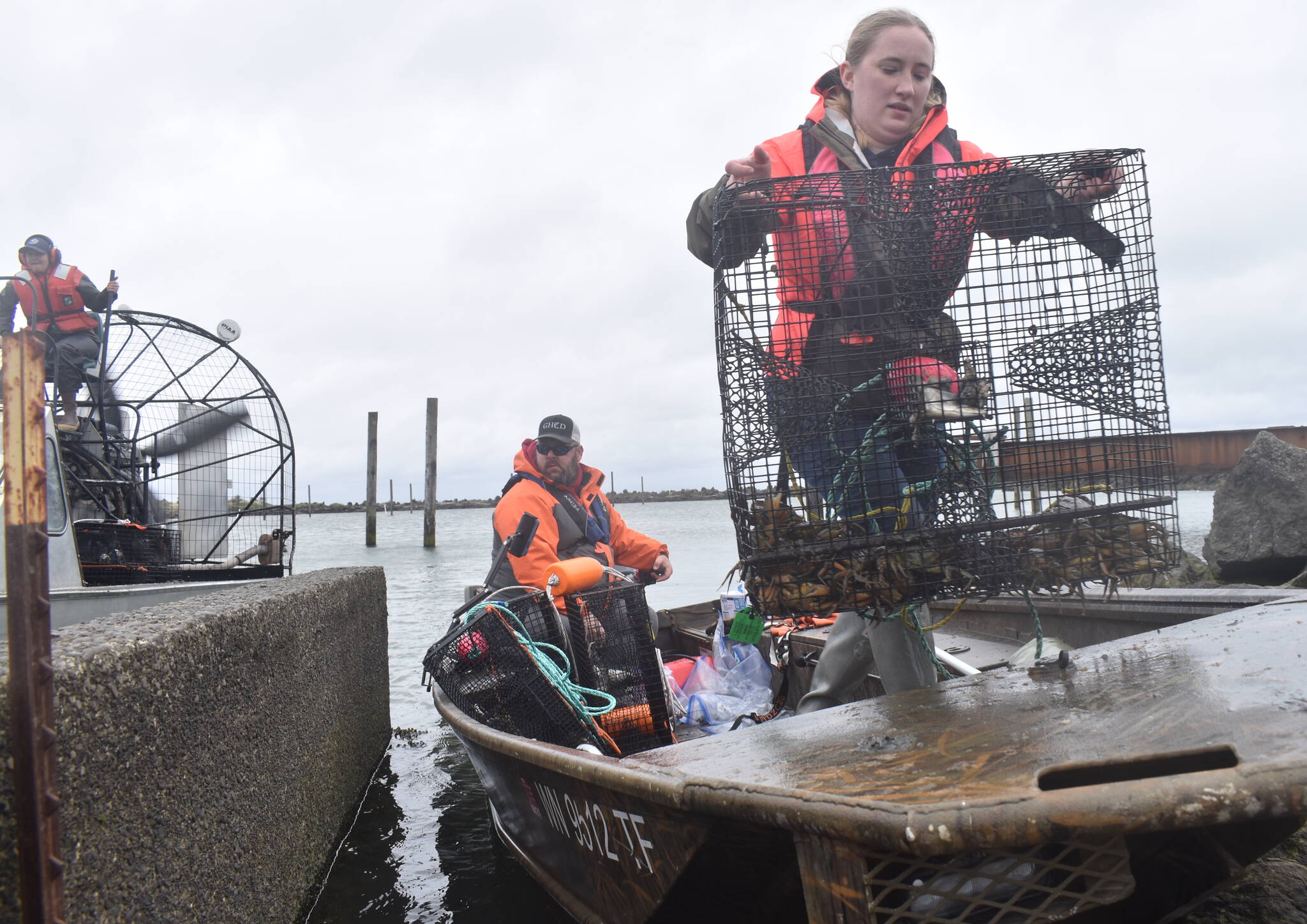Perched on a raised stool aboard a small metal boat, Alexa Brown pushed down on a long throttle, kicking up sea spray as a large fan spun to life. Brown eased the boat toward a string of orange buoys, with crab pots settled below, and strong winds at the rocky mouth of the marina proved too hostile for the fan-powered boat to handle.
Luckily, there are reinforcements in the ongoing battle against one of the most harmful intruders to coastal estuaries: European Green Crab.
As Brown, who coordinates green crab trapping efforts for the Washington Department of Natural Resources, guided her boat to shore, a crew from the Grays Harbor Conservation District, riding in a motor-powered dinghy, retrieved the state-owned traps the air boat couldn’t reach.
Those were among the 120 traps three different agencies placed in the Quinault Marina in Ocean Shores last week, a three-day effort that removed more than 2,100 green crab. These kinds of trapping efforts are the most common weapon natural resource agencies use to thwart proliferating populations of green crab, a voracious predator posing negative impacts to shellfish, habitats and the health of native ecosystems.
More than two years ago Gov. Jay Inslee declared a state of emergency over the green crab invasion. Since then about 678,000 crab have been removed from Washington waters, including 31,000 so far in 2024, according to the Washington Department of Fish and Wildlife.
Last year, most of the captures occurred in Grays Harbor and Willapa Bay, with 85,000 crab pulled from Grays Harbor and more than three times that pulled from Willapa.
Since late in 2023, the Grays Harbor Conservation District’s green crab crew has pulled more invaders from the Quinault Marina than any other of its dozen sites in the Chehalis River estuary, said Olivia Britain, a crew member.
She and Moose Marmot, who make up the conservation district’s green crab team, use satellite maps to identify places with rocky habitat, shallow water and tidal fluctuation where green crabs are likely hiding. They started trapping at the marina last fall with permission from the Quinault Indian Nation, owners of the marina.
Last week was the first time state agencies joined the district trapping at the Quinault Marina.
“This is likely a place green crab have been for a really long time,” said Alex Stote, a coastal green crab specialist with Washington Sea Grant, who helped collect data Thursday and as crews pulled traps of green crab to shore. That was evidenced by the barnacles protruding from some green crab shells.
Considered one of the world’s most damaging invasive species, European green crab arrived in Washington state more than 25 years ago. The population boomed in the last five years, leading to the emergency order and increased trapping measures to curtail the crab.
In 2023 the state Legislature appropriated $12 million for green crab management including $500,000 apiece for the Grays Harbor and Pacific conservation districts and shellfish growers in the Twin Harbors.
“We have continued to recommend that Gov. Jay Inslee maintain the EGC (European green crab) emergency order because of the serious threat these crab pose to Western Washington’s environment and economy,” Bridget Mire, a spokesperson with the Washington Department of Fish and Wildlife, said in an email. “While we don’t expect to eradicate EGC from Washington because of their high numbers, our goal is to keep populations below levels harmful to environmental, economic, or cultural resources.”
To be effective, Stote said, trapping needs to involve “continued pressure, high frequency, and high-volume removal” — catching a lot of crab a lot of the time.
Stote and other scientists use data from trapping efforts to follow trends in crab populations, which can naturally fluctuate year to year. According to Brian Turner, a research scientist with fish and wildlife, data from 2022 and 2023 shows evidence of reduced green crab numbers in certain areas where trapping is ongoing. Populations have stagnated in other trapping areas, and despite reaching the north Olympic Peninsula and Hood Canal, green crab haven’t infiltrated South Puget Sound, at least not that managers are aware of.
With more data and trapping experience, managers can target specific patterns, like an abundance of egg-bearing females. Stote said a pattern has emerged of females during the late summer and fall months. Brown, of the DNR, said that while sex ratios in populations are site specific, spring can also produce higher rates of females. Crews caught about 70% females in the Elk River estuary last week.
Female green crab can reproduce twice in one season, spawning up to 185,000 eggs at a time. Crab teams found dozens of gravid — egg-carrying — females in traps last week, which is usually an indication of an established population.
But catching the most crab as possible, rather than keying in on sex, is the more crucial aspect to trapping, Brown said.
“Hopefully we’re getting the females and hopefully we’re getting the crabs that are here,” Brown said. “But we’re going to be still trapping this site for a very long time.”
Contact reporter Clayton Franke at 406-552-3917 or clayton.franke@thedailyworld.com.


